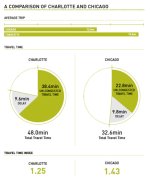Driven Apart, a new report from CEOs for Cities, unveils the real reason Americans spend so much time in traffic and offers a dramatic critique of the 25 year-old industry standard created by the Texas Transportation Institute's Urban Mobility Report (UMR), which is often used to justify billions of dollars in expenditures to build new roads and highways. The surprising analysis by Joe Cortright, senior policy advisor for CEOs for Cities, says the solution to this problem has much more to do with how we build our cities than how we build our roads.
"As someone who has long believed in the impact of land uses and community design on travel behavior, I am pleased to see this thoughtful critique of our inadequate approach to measuring traffic congestion," said Congressman Earl Blumenauer (D-OR), Congress’ chief advocate for federal policies that address transportation alternatives, provide housing choices, support sustainable economies and improve the environment. "This report should be required reading for anyone interested in reducing the time Americans spend stuck in traffic and improving the livability of our communities."
Introduction & Presentation by Tim Lomax (5 minutes)
Presentation by Joe Cortright (below, 17 minutes)
Lomax's Rebuttal (7 minutes)
Q&A (30 minutes)
A highlight: during his rebuttal, Lomax readily acknowledges that TTI is wrong about its gas mileage estimates but offers no explanation for why they knowingly published the 2010 report despite this inaccuracy (video 3, cue 5:11).
In fact, a close examination shows that the UMR has a number of major flaws that misstate and exaggerate the effects of congestion, particularly the Travel Time Index, which is the ratio of average peak hour travel times to average free flow travel times. Furthermore, for the 51 metropolitan areas analyzed in Driven Apart, the UMR overstates the cost of congestion by about $49 billion. Because this methodology does not take into account travel distances, it universally rewards cities that are spread out as opposed to compact urban areas. An example of this distorted preference can be seen in this comparison of Chicago and Charlotte:

“The key role of sprawling development patterns in driving peak period traffic and the limitations of the Urban Mobility Report underscore the need for a much improved system for measuring and comparing the performance of urban transportation systems," offers Cortright. "Such a system should incorporate better and more precise data about speeds but also specifically track travel distances and land use patterns."
A flawed report on traffic congestion (Washington Post)
Putting numbers to drivers' misery (Washington Post)
Urban mobility report paints flawed picture of congestion, solutions (Smart Growth America)
Congestion report pushes sprawl through flawed analysis (Greater Greater Washington)
New report ranks congestion in America's cities (The Infrastructurist)
Why building roads creates traffic (The Infrastructurist)
"As someone who has long believed in the impact of land uses and community design on travel behavior, I am pleased to see this thoughtful critique of our inadequate approach to measuring traffic congestion," said Congressman Earl Blumenauer (D-OR), Congress’ chief advocate for federal policies that address transportation alternatives, provide housing choices, support sustainable economies and improve the environment. "This report should be required reading for anyone interested in reducing the time Americans spend stuck in traffic and improving the livability of our communities."
Joe Cortright Debates TTI's Tim Lomax at Congress for New Urbanism Salon
At a Salon Session hosted by the Congress for New Urbanism on June 2, 2011, Cortright debated Tim Lomax of the Texas Transportation Institute who authors the Urban Mobility Report. The debate was videotaped and can be viewed here in four parts:Introduction & Presentation by Tim Lomax (5 minutes)
Presentation by Joe Cortright (below, 17 minutes)
Lomax's Rebuttal (7 minutes)
Q&A (30 minutes)
A highlight: during his rebuttal, Lomax readily acknowledges that TTI is wrong about its gas mileage estimates but offers no explanation for why they knowingly published the 2010 report despite this inaccuracy (video 3, cue 5:11).
More about Driven Apart
Driven Apart is a peer-reviewed, 60-page critique of the Urban Mobility Report, its data and methodology that was published by CEOs for Cities with support from The Rockefeller Foundation. It reveals how sprawl is lengthening our commutes and why misleading mobility measures are making things worse by suggesting more highways are the solution.In fact, a close examination shows that the UMR has a number of major flaws that misstate and exaggerate the effects of congestion, particularly the Travel Time Index, which is the ratio of average peak hour travel times to average free flow travel times. Furthermore, for the 51 metropolitan areas analyzed in Driven Apart, the UMR overstates the cost of congestion by about $49 billion. Because this methodology does not take into account travel distances, it universally rewards cities that are spread out as opposed to compact urban areas. An example of this distorted preference can be seen in this comparison of Chicago and Charlotte:

“The key role of sprawling development patterns in driving peak period traffic and the limitations of the Urban Mobility Report underscore the need for a much improved system for measuring and comparing the performance of urban transportation systems," offers Cortright. "Such a system should incorporate better and more precise data about speeds but also specifically track travel distances and land use patterns."
Support for Driven Apart
Building roads only causes more traffic (Fast Company)A flawed report on traffic congestion (Washington Post)
Putting numbers to drivers' misery (Washington Post)
Urban mobility report paints flawed picture of congestion, solutions (Smart Growth America)
Congestion report pushes sprawl through flawed analysis (Greater Greater Washington)
New report ranks congestion in America's cities (The Infrastructurist)
Why building roads creates traffic (The Infrastructurist)
